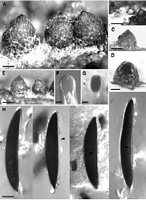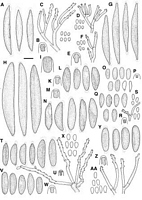|
 Rosellinia longispora Rosellinia longispora
BiostatusPresent in region - Indigenous. Non endemic
Images (click to enlarge)
Caption: Fig. 18 Rosellinia longispora. A-C, E, Stromata, A, B, E showing subiculum; D, Vertical
section of stroma; F, Ascus apical ring shown by Nomarski contrast; 
Caption: Fig. 8 A-D, Rosellinia arcuata, PDD 41969: A, Ascospores; B, Ascus apical ring; C,
Conidiophores and conidia on the host; D, Conidiophores and conidia on OA; E-G, R.
freycinetiae, PDD 20580: E, Ascus a | |
Article: Petrini, L.E. (2003). Rosellinia and related genera in New Zealand. New Zealand Journal of Botany 41(1): 71-138 (http://www.rsnz.org/publish/abstracts.php).
Description: Subiculum evanescent, in young material white to grey, felty, absent in mature and old
material. Stromata (600)710 ± 76(800) µm high, (575)730 ± 105(850) µm wide (n = 5),
conical, black, leaving a ring on the substrate when detached, solitary or crowded in small
groups, sometimes fused together, seating on a common stromatal base. Ostioles pointed,
hardly differentiated. Ectostroma 25- 50 µm, black. Entostroma absent in mature material.
Perithecia detached in older material. Ascus apical rings (13.4)14.2 ± 0.8(15.4) µm high,
upper width 7.6-8.6 µm, lower width 5.7-7.7 µm (n = 5), J+, dark blue. Ascospores (60.5)71.2
± 3.8(78.7) µm long, (9.6)11.5 ± 0.9(13.4) µm wide (n = 30), banana-shaped, brown to dark
brown, with straight germ slit extending the whole spore length, both extremities and flattened
to concave side surrounded by a slimy sheath.
Habitat: HOST: Rhopalostylis sapida.
MATRIX: Rachides.
Notes: NOTES: Rosellinia longispora is characterised by long ascospores with a germ slit extending
the whole spore length and a poorly developed, evanescent subiculum. It was possible to
compare the New Zealand specimen with original material of R. longispora from the Rick
collections held at FH and PACA. The discriminant analysis revealed that there is no
statistically significant difference in the size of the ascospores; analysis of variance
demonstrated the same for stromata, and ascus apical rings (results not shown). The Rick
material is on decorticated dicotyledonous wood, whereas the New Zealand specimen is on
palm fronds.
The type material of R. emergens (Berk. & Broome) Sacc., K, has morphologically similar
ascospores, but the subiculum is persistent and well developed, dark brown, and wiry (L. E.
Petrini unpubl. data). R. formosana Y.-M.Ju & J.D.Rogers has wider, differently shaped
stromata and larger ascospores than R. longispora (Ju & Rogers 1999).
|